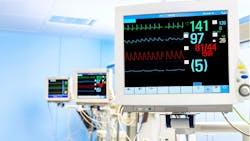Patient Monitoring Check-In with GE Healthcare
Patient monitoring technologies and techniques have evolved at a rapid pace over the past few years, in part due to the COVID-19 pandemic. Recent studies show that patient monitoring, especially remote patient monitoring (RPM), has a high level of patient satisfaction and compliance.
According to a study from the Mayo Clinic, patient engagement improved with RPM. Over 7,000 patients across 41 states participated in the study, which found patient engagement with digital RPM tools was as high as 80%. Additionally, the study found that patient compliance with care plans among high-intensity patients who use RPM devices was slightly over 70%.
Further, a KLAS Research survey found that 38% of healthcare organizations running RPM programs focused on chronic care management reported a reduction of admissions, while 17% reported cost reduction.
Healthcare Purchasing News conducted a Q&A with Neal Sandy, general manager, Monitoring Solutions, Patient Care Solutions, GE HealthCare, to get an update on the current state of patient monitoring from the organization’s perspective.
Editor’s Note: The study mentioned in Sandy’s responses, entitled, “The State of Flexible Healthcare Delivery”, has some interesting statistics on the state of healthcare delivery today. GE HealthCare commissioned healthcare consultancy Sage Growth Partners to research and develop the report (double blinded research, conducted independently by Sage). They surveyed 204 hospital and health system executives and leaders in the U.S. and held qualitative interviews with several respondents. The study can be found here: https://clinicalview.gehealthcare.com/article/state-flexible-healthcare-delivery.
What trends are you seeing when it comes to patient monitoring? What were you seeing pre- and now post-COVID?
In the past, patient monitors were generally purchased for a specific care area. For example, hospitals have specific monitors for the intensive care unit (ICU) and different monitors, typically with fewer capabilities, for the emergency department (ED). However, the COVID pandemic highlighted the need to have flexible patient monitoring technologies that could easily adapt to meet a patient’s acuity level. As hospitals had to quickly adjust from normal to surge operations to respond to the increase in COVID cases, it would have been ideal if the monitors deployed in lower acuity settings had the capability to provide ICU level monitoring. Flexible, scalable solutions allowing institutions to customize on the fly for all patients and case types help drive more efficient, confident care.
What are challenges hospitals/health systems experience when it comes to patient monitoring?
Flexibility
What we hear from customers every day is that they need flexibility, now and into the future. At GE HealthCare we term this FlexAcuity, the ability to flex capabilities based on individual patient needs and transition seamlessly between care areas across the enterprise. It means you have a unified monitoring platform that can adapt with your needs and is ready for the future.
For example, imagine one monitoring ecosystem with the potential for a hospital to have a single unified approach to patient monitoring that can be easily tailored for each patient, where software and patient parameters can change in a very nimble manner. This enables care teams to focus on the patient, not the technology.
Burnout/Staff Shortages
Clinicians and care teams are plagued with burnout, alarm fatigue, and staff shortages. They need reliable technologies that deliver meaningful alarms and actionable data.
Scaling Technology
Purchasing patient monitoring [technologies] often includes not only the individual monitoring devices, but also the ecosystem. This can take many forms but often includes connectivity to central stations, remote viewing, integration to electronic health record systems, and data exchange with other hospital IT systems and platforms. Therefore, it’s important to evaluate a vendor’s ability to support your purchasing needs not only today, but also into the future. Can future purchases work with past investments? Can the technology scale as your enterprise grows or changes over time? Is there an easy path to give your clinicians access to new technology as your standards of care evolve or new parameters and clinical measurements are introduced? Backward compatibility allows healthcare systems to upgrade to the latest capabilities at their own pace.
What are organizations doing to overcome these challenges?
Flexible healthcare, or a health system’s ability to purposefully innovate in the face of changing conditions with speed of implementation, scale, and organizational alignment, will be key. A recent study finds that ongoing workforce shortages are a main factor driving the increased movement toward flexible care models. Continuous patient monitoring to alert changes in acuity, visual dashboards for monitoring patient status, and standardizing monitoring devices to reduce training time were all considered important to a flexible care model. 66% of respondents felt organizations implementing flexible care models had a stronger bottom line as a result and even more said these models increased staff efficiency.
Increasingly, organizations are seeking longer term partnerships because they understand that an enterprise-wide monitoring solution requires a commitment from both the hospital and the monitoring solution provider. Organizations are asking about total cost of ownership over the lifecycle of the products and solutions they intend to purchase. They are asking for evidence that the proposed solutions deliver either clinical or economic benefit, or both.
Where do you see this space in the next 5-10 years?
Clinicians and care teams are plagued with burnout, alarm fatigue, and staff shortages. They will need reliable technologies that deliver meaningful alarms and actionable data.
Continuous patient monitoring in subacute care settings will be increasingly important, yet relevant only when patient mobility is elegantly addressed.
The evolution of artificial intelligence/machine learning based multiparameter intelligence, including predictive algorithms and clinical decision support, will accelerate when the liberation of deidentified patient data becomes standard and access to vast, annotated datasets becomes readily available.
Finally, the evolution of technology is accelerating, so business models will need to change to allow organizations to keep pace. Monitoring, as a service, will overtake standard capital equipment purchasing as clinicians and hospitals make note of how this pace of change affects clinical and operational outcomes.
Any additional thoughts?
Patient mobility is key to recovery so monitors, especially in MedSurg and recovery units, need to support the patient getting up out of bed and walking around. Wireless and wearable continuous monitoring that complements efficient nursing workflows provides a real-time personalized view of the patient while encouraging mobility. Clinicians are increasingly asking for the leading indicators of deterioration, respiration rate, oxygen saturation, and pulse rate to be measured continuously in order to intervene proactively.


